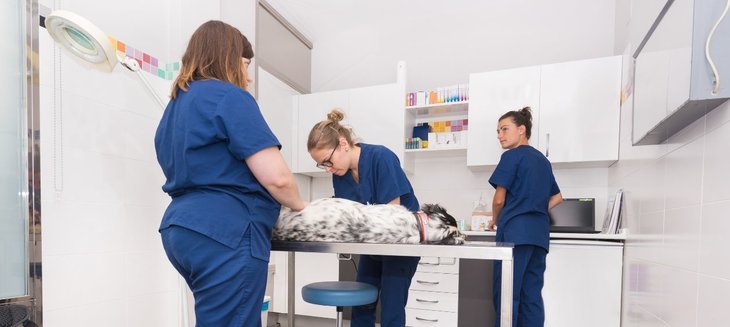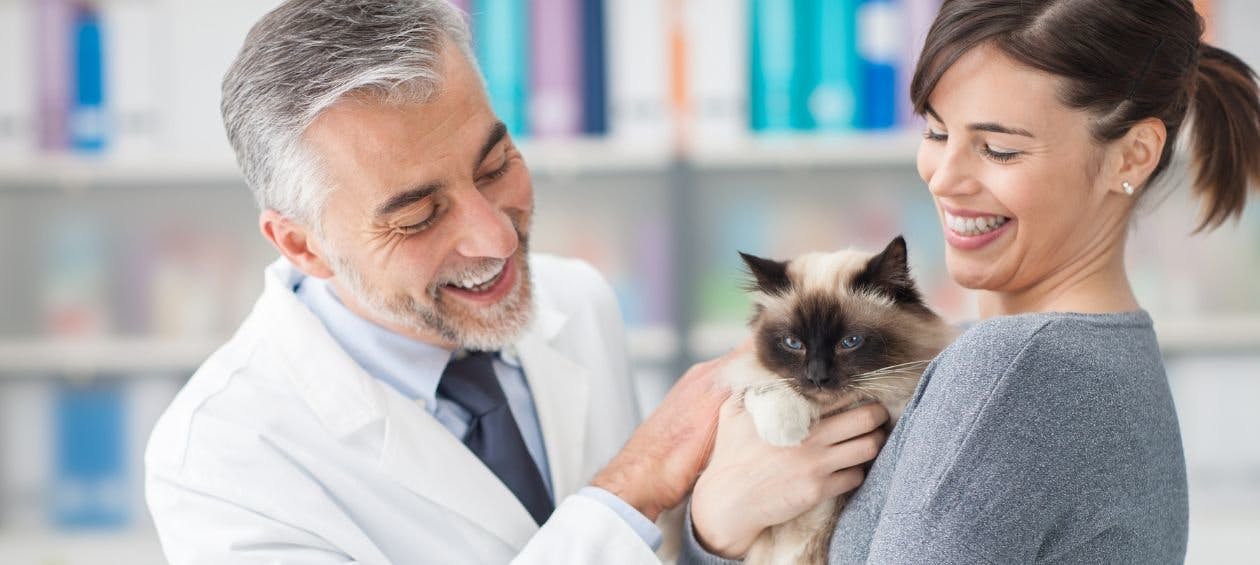How to Improve Communication in the Veterinary Practice
A visit to the vet office can be a stressful experience for pet owners and patients alike. Owners often have to restrain and comfort their pets throughout the appointment while also completing their check-in forms, communicating health concerns, and contemplating potential outcomes. Sitting in the lobby waiting to be placed in an exam room can seem like a never-ending ordeal, but how we communicate with them can make a huge difference .
In the world of animal care, effective communication plays a crucial role in ensuring positive experiences — not only for clients seeking care for their four-legged friends but also between staff members within the practice. When it comes right down to it, good communication is the key to fostering trust, driving client satisfaction, promoting productivity, and most importantly, providing the best possible care for our patients .
80%
of veterinary clients decline treatment recommendations out of confusion
In fact, an estimated 80% of clients do not undergo treatment recommendations due to confusion, but this is something that can be avoided if the veterinary team takes an active role in communicating effectively. 1
In this post, we will delve into the importance of communication in veterinary practices, highlighting its benefits while also exploring practical strategies designed to improve these invaluable interactions . So, whether you're a veterinarian, technician, or practice manager, this insightful read promises to better equip you for navigating the day-to-day challenges of your chosen field.
Table of Contents:
Why is communication important in a veterinary practice?
Communication in the veterinary workplace is important on multiple levels: internally, between team members, and externally, within our client-facing interactions. Here are a few reasons why:
- Communication between staff members is the backbone of a veterinary clinic. Whether it's discussing a patient's health, delegating tasks, or coordinating surgeries, efficient information exchange is crucial. Miscommunications or misunderstandings can result in delays, mistakes, or even jeopardize a patient's health .
- Communication between staff is also important in gaining and keeping trust between the veterinary team and the client. If clients get differing messages from your team members, this will degrade their trust in the practice and decrease their overall experience during their visit .
- Clients entrust veterinarians with the health and well-being of their beloved pets. To ensure they fully understand the treatment, prognosis, and post-care , veterinarians must communicate clearly and compassionately with pet owners.
- Furthermore, clients often have fears or concerns that require reassurance. Addressing these with empathetic communication can go a long way in establishing trust .

We Help Vet Teams Communicate
Save time while ensuring patients have access to essential care with Pawlicy Advisor, the Preferred Partner of the American Animal Hospital Association.
Benefits of effective communication in the veterinary workplace
There are several distinct benefits of effective communication for vets, including:
Improves patient care and a better client experience
When the veterinary team communicates well, they can make more accurate diagnoses, create cohesive treatment plans, and ensure every team member understands their role in the patient’s care. With everyone on the same page, the likelihood of errors is minimized.
Enhances client satisfaction and retention
Clients value transparency and understanding. They want to feel like they have a choice when it comes to their pet’s care and can play an active role in making that choice. They don’t want to feel like that choice is being made for them.
When they are well informed about their pet’s health, the recommended procedures, and the reasons behind them, they are more likely to feel satisfied and confident in the veterinary team. This trust ensures that they return for their pet's future needs.
Increases team efficiency and productivity
When veterinary teams communicate effectively, there’s less back-and-forth, fewer misunderstandings, and quicker decision-making. A team that communicates well can attend to more patients in a day without compromising on the quality of care and with less risk of becoming burnt out due to frustrating miscommunications.

Strategies for improving communication in veterinary practices
1. Implement efficient talk tracks within the practice
As part of your training program, consider implementing standardized scripts for common scenarios (like welcoming a client to your practice or delivering unfortunate news) to provide veterinarians and staff with guidelines that promote clarity and consistency. This ensures that important details aren’t missed and that clients receive a uniform message.
For instance, many veterinary hospitals proactively introduce the topic of pet insurance with all new clients . It’s crucial to educate pet owners about the benefits of pet insurance and how it can help them afford essential medical care their pet may be likely to require down the road, which can be expensive to pay for out-of-pocket.
Being upfront about these costs early on helps prevent the sticker shock that often occurs when clients are faced with unexpected vet bills they’re financially unprepared to cover . By equipping everyone with the same script and talking points, your practice can ensure that the message is conveyed clearly and consistently so that fewer clients are caught off guard, and fewer patients go without treatment.
Pawlicy Advisor Simplifies the Pet Insurance Conversation
We make it easy for vets to enroll more clients without having to become insurance experts, so you can free up your time and attention to focus on what matters most: delivering the best care to more patients.
2. Develop training programs for veterinary staff
Investing in regular training sessions can help staff understand the best way they communicate and strive to develop their communication skills. This can include workshops on active listening, empathy, non-verbal cues, and effective ways to communicate with clients in layman's terms. Be sure everyone in the office gets the opportunity to learn these critical communication skills, including receptionists, technicians, practice managers, veterinarians, and their assistants.
It’s important to understand that everyone communicates differently. Some people appreciate the details of why something is important, while others need the mile-high understanding of a situation. Find out how different team members learn and curate your communication with them in that way.
3. Encourage open dialogue and feedback among team members
A culture that promotes open dialogue allows team members to voice concerns, share insights, and seek clarification without hesitation. Open communication doesn’t happen by accident. Leaders of the veterinary team must create cultural shifts and set an example by giving the staff a vision of where the business is going and where their role fits into that vision. In addition, practice leaders should encourage feedback and, when it comes, be open to implementing changes that could add value to the business.
Regular team meetings where members can discuss cases, share experiences, and provide feedback can help foster a communicative environment. One way you can do this is by having a quick, five– to ten-minute huddle before the day begins. This allows you to align the team on the same page, shift roles if necessary, and plan which veterinarian is going to be responsible for which patients.

4. Prevent breakdowns in communication
Effective communication reduces medical errors. It has been shown that communication typically breaks down during shift changes or case transfers, increasing the likelihood of medical error. To eliminate this communication gap and the errors that result, many human medical specialties have developed a standardized communication system for patient handoffs known as "I-PASS", which can be adapted to fit veterinary medicine.
The I-PASS communication system is a standardized handoff protocol that ensures that important patient information is consistently and accurately communicated between professionals during transitions of care. Adapting this system for veterinary professionals can enhance the quality of patient care, reduce errors, and improve communication amongst team members. 2
I-PASS Communication System For Veterinary Professionals
I: Illness Severity - Is the patient’s condition stable, improving, or deteriorating?
P: Patient Summary - A brief summary of the patient, their diagnosis, and current treatment plan
A: Action List - Are there any pending tests and treatments?
S: Situation Awareness and Contingency Plans - What potential issues might arise? What is the plan if they do?
S: Synthesis by Receiver - The receiving provider summarizes the information back to ensure understanding
For a sample verbal handoff and additional information about I-PASS use for veterinary medicine, view the entire JAVMA article here.
During the I-PASS handoff, it's essential to minimize interruptions and ensure a quiet environment to foster clear communication. Using this structured approach can be particularly beneficial during busy shifts or when dealing with complicated cases in veterinary settings.
Final Thoughts
In the end, veterinary practices are as much about treating animals as they are about connecting with people. As with all healthcare, trust is paramount, and this trust is built and nurtured through effective communication.
By acknowledging the pivotal role of communication, understanding its benefits, and actively working on strategies to enhance it, veterinary practices can provide exemplary patient care, earn the unwavering trust of clients, and operate with peak efficiency. In the vast ecosystem of veterinary medicine, communication is the thread that binds every element together, making it an indispensable tool for success.
References:
- VetCheck Technologies. Why good communication is key to good veterinary practice. Published online, accessed October, 12, 2023. https://vetcheck.it/communication/
- Cummings CO, Krucik DDR, Carroll JP, Eisenbarth JM. Improving within-team communication to reduce the risk of medical errors. Journal of the American Veterinary Medical Association. Published online February 2, 2022:1-3. doi:https://doi.org/10.2460/javma.21.09.0407
Do you want to find the best pet insurance?
Let's analyze your pet's breed, age, and location to find the right coverage and the best savings. Ready?
Analyze My PetAbout Pawlicy Advisor
The pet insurance marketplace endorsed by veterinarians, at Pawlicy Advisor we make buying the best pet insurance easier. By comparing personalized coverage and pricing differences we can save you a ton of money, up to 83% in some instances!
Instantly Compare Pet Insurance Plans
Guides
Determine If Pet Insurance Is Worth It
Comparison Charts
Find Your State
Dog Insurance
DVM
Adam Thompson, DVM, is a small animal veterinarian at a private practice in north Alabama. He enjoys educating pet owners and providing them with the best care possible for their pets. He has a passionate interest in nutrition, dentistry, dermatology, and preventative medicine. Dr. Thompson is married to his wife (also a veterinarian), and they have two children. They also have a Boston Terrier mix named Newman.
